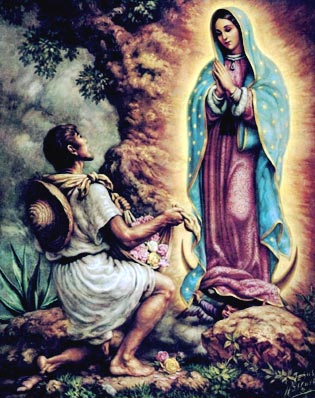12 December
Feast of Our Lady of Guadalupe

Patron: The Americas, and The Pro-life movement
In 1910 Our Lady of Guadalupe was declared Patroness of Latin America, and in 1945 Pope Pius XII declared Her to be the Empress of all the Americas. She appeared to an Indian convert named Juan Diego on December 9, 1531. She left a marvelous portrait of herself on the mantle of Juan Diego. This miraculous image has proved to be ageless and is kept in the shrine built in her honor, the Basilica of Our Lady of Guadalupe.
COLLECT PRAYER
O God, Father of mercies, who placed your people under the singular protection of your Son’s most holy Mother, grant that all who invoke the Blessed Virgin of Guadalupe, may seek with ever more lively faith the progress of peoples in the ways of justice and of peace. Through our Lord Jesus Christ, your Son, who lives and reigns with you in the unity of the Holy Spirit, God, for ever and ever.
[A brief account]
Juan Diego, a poor Aztec widower was on his way to attend Mass in honour of Our Lady. Walking by Tepeyac Hill, he heard beautiful music and a radiant cloud appear, and within it stood an Indian maiden dressed like an Aztec princess. The lady spoke to him in his own language and sent him to the bishop of Mexico, a Franciscan named Juan de Zumarraga requesting that a shrine be built to her where she appeared. Eventually, the bishop told Juan to have the lady give him a sign. At about this same time Juan’s uncle became seriously ill. She again appeared to Juan and assured him that his uncle would recover, and provided roses for Juan to carry to the bishop in his cape. When Juan Diego opened his cape in the bishop’s presence, the roses fell to the ground, and the bishop sank to his knees. On the cape where the roses had appeared an image of Mary exactly as she had appeared at Tepeyac Hill. The image is now venerated in the Basilica of Guadalupe. Each year, hundreds of thousands of pilgrims flock to the church, the holiest in Mexico, which was given the status of basilica in 1904.
Things to Do:
- Start a novena to Our Lady of Guadalupe.
- If you live close to La Crosse, WI, visit the beautiful Shrine of Our Lady of Guadalupe; if not make a virtual visit.
- Read more about this title of Our Lady.
- Make a sacrifice, say a prayer or visit the Blessed Sacrament for an end to abortion.
- If your parish is having a pro-life Mass or holy hour, try to attend.
- Have a party, which includes a procession and a special Mexican dinner to celebrate the feast.
- See Celebrating the Feast of Our Lady of Guadalupe for ideas.
“Hear me and understand well, my son the least, that nothing should frighten or grieve you. Let not your heart be disturbed. Do not fear that sickness, nor any other sickness or anguish. Am I not here, who is your Mother? Are you not under my protection? Am I not your health? Are you not happily within my fold? What else do you wish? Do not grieve nor be disturbed by anything.” — Our Lady to Juan Diego

In the winter of 1531, a poor, 57-year-old Aztec widower living five miles outside of Mexico City encountered a miraculous happening on his way to morning Mass. First he heard strange music coming from Tepeyac Hill, and then he heard a woman’s voice calling his name. Juan Diego climbed the hill and encountered a young woman, appearing to be of his own people in physical appearance and dress. The woman identified herself as the Virgin Mary, and told Juan Diego to ask the bishop of Mexico City to build a church on the hill to assist in the conversion of the nation and be a source of consolation to the people.
Juan Diego obeyed the request, but the bishop was skeptical regarding the message, even though he perceived that Juan was a humble, and well meaning Catholic. Juan reported the bishop’s doubt to Our Lady at Tepeyac Hill, and she asked him to return to the bishop once again, bearing the same message. The bishop once again heard the story, and told Juan Diego to ask Our Lady for a sign that it was indeed herself that wished for the church to be built.
When he returned to the hill, Mary gave Juan Diego such a sign. Miraculously, roses appeared on the hill in the middle of winter, and Juan gathered them in his tilma, or cloak. Our Lady arranged the roses in his tilma with her own hands, and Juan returned to the bishop’s presence. When Juan released the tilma, allowing the flowers to fall to the floor, it was revealed that a miraculous image of Our Lady had imprinted itself on his tilma (see above).
The bishop immediately fell to his knees, and came to believe in Juan Diego’s message. A church was built on the spot of the apparition, as Mary had requested, and 8 million people converted to Catholicism in a short period of time upon hearing of or viewing the miraculous image of Our Lady.
The tilma of Juan Diego has been the subject of much modern research. The tilma, woven out of coarse cactus fiber, should have disintegrated after 20 years, but although over 500 years have passed the tilma is still in perfect condition. The pupils of Mary in the picture reflect the Indians and clergy present at the time of the first revelation of the image. No paint was used, and chemical analysis has not been able to identify the color imprint. Additionally, studies have revealed that the stars on Mary’s mantle match exactly what a Mexican would have seen in the sky in December of 1531.
Source Catholic Culture